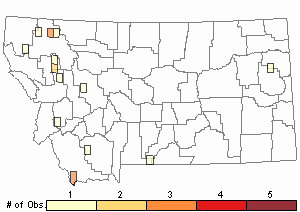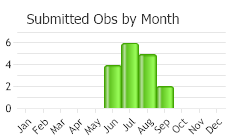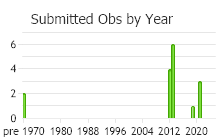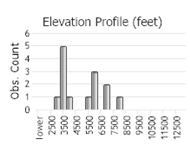View in other NatureServe Network Field Guides
NatureServe
Montana
Utah
Wyoming
Idaho
Wisconsin
British Columbia
South Carolina
Yukon
California
New York
A Hook Moss - Drepanocladus polygamus
Other Names:
Campylium polygamum
General Description
Plants: Pleurocarpous (Vitt 1988). Growing in open to crowded, somewhat glossy mats, green with yellow or brown tinges to brown. Stems creeping to curving upward (Crum & Anderson et al. 1981), somewhat pinnate or freely forked, the scant branching in one plane; possessing a central strand; hyalodermis and paraphyllia wanting; rhizoids or their initials produced on the dorsal side of the costal attachment or on the stem, not forming woolly mats (FNA 2014).
Leaves: Stem leaves spreading to a little more upright, curved like a sickle or straight, egg-shaped, sometimes widely so, or deltoid with rounded angles, tapering to form a long acumen, cupped, 1.3-3.5 mm in length and 0.6 – 1.1 mm in width; margins smooth or sometimes wavy, unbordered; acumen grooved; base spreading to a little more upright; costa single (or eventually forked) and extending to half the leaf length or a little more or paired and not reaching mid leaf (FNA 2014), the double costa rare (Crum & Anderson et al. 1981).
Leaf Cells: Alar cells differentiated, swollen, transparent (FNA 2014) to golden (Crum & Anderson et al. 1981), the area forming a well-demarcated triangle across the leaf, extending from 2/3 to the entire distance from the leaf edge to the costa; marginal cells in 1 layer (FNA 2014); distal cells very thin (Crum & Anderson et al. 1981).
Diagnostic Characteristics
The similar Campylium stellatum has wider leaves that spread more (Crum & Anderson et al. 1981).
Range Comments
North American Range
AK to NL and NS, CA, WA sw to CO, MN s to MO, WI, OH, NY and scattered to ME, also FL (FNA 2014). Known in Montana from Flathead, Lewis and Clark, and Richland Counties (Elliott 2016).
Observations in Montana Natural Heritage Program Database
Number of Observations: 18
(Click on the following maps and charts to see full sized version)
Map Help and Descriptions
Relative Density

Recency



 (Observations spanning multiple months or years are excluded from time charts)
(Observations spanning multiple months or years are excluded from time charts)
Habitat
Organic soil in meadows, forested bogs (Crum & Anderson et al. 1981), and other wetlands high in minerals and nutrients, underwater in lakes and ponds. Elevation: low to high (FNA 2014).
Reproductive Characteristics
Autoicous and polygamous. Seta mostly 1.5-3.5 (up to 5) mm tall (Crum & Anderson et al. 1981). Capsule bowed and level; margins of exostome smooth a little toothed above; endostome cilia knobby and sometimes transversely ridged (FNA 2014).
Stewardship Responsibility
References
- Literature Cited AboveLegend:
 View Online Publication
View Online Publication Crum, H.A. and L.E. Anderson. 1981. Mosses of Eastern North America. 2 volumes. Columbia University Press, New York. 1328 pp.
Crum, H.A. and L.E. Anderson. 1981. Mosses of Eastern North America. 2 volumes. Columbia University Press, New York. 1328 pp. Elliott, J.C. and A.K. Pipp. 2018. A Checklist of Montana Mosses (1880-2018). Updated 3 January, 2020. Montana Natural Heritage Program, Helena, Montana. 73 pp.
Elliott, J.C. and A.K. Pipp. 2018. A Checklist of Montana Mosses (1880-2018). Updated 3 January, 2020. Montana Natural Heritage Program, Helena, Montana. 73 pp. Flora of North America Editorial Committee, eds. 2014. Flora of North America North of Mexico. Volume 28. Bryophytes: Mosses, Part 2. Oxford University Press, Inc., NY. xxi + 702 pp.
Flora of North America Editorial Committee, eds. 2014. Flora of North America North of Mexico. Volume 28. Bryophytes: Mosses, Part 2. Oxford University Press, Inc., NY. xxi + 702 pp. Vitt, D. J. Marsh, and R. Bovey. 1988. Mosses, Lichens & Ferns of Northwest North America. Seattle, WA: University of Washington Press. 296 p.
Vitt, D. J. Marsh, and R. Bovey. 1988. Mosses, Lichens & Ferns of Northwest North America. Seattle, WA: University of Washington Press. 296 p.
- Additional ReferencesLegend:
 View Online Publication
View Online Publication
Do you know of a citation we're missing? Elliot, J. C. 1993. Second checklist of Montana mosses. Unpublished report. U.S. Forest Service, Region 1. Missoula, MT. 45 pp.
Elliot, J. C. 1993. Second checklist of Montana mosses. Unpublished report. U.S. Forest Service, Region 1. Missoula, MT. 45 pp. Flowers, S. 1973. Mosses: Utah and the West. Brigham Young University, Provo, Utah. 567 p.
Flowers, S. 1973. Mosses: Utah and the West. Brigham Young University, Provo, Utah. 567 p. Lawton, E. 1971. Keys for the Identification of the Mosses on the Pacific Northwest. Reprinted from 'Moss Flora of the Pacific Northwest'. Published as Supplement No. 2 of the Journal of the Hattori Botanical Laboratory. Nichinan, Miyazaki, Japan. 66 pp.
Lawton, E. 1971. Keys for the Identification of the Mosses on the Pacific Northwest. Reprinted from 'Moss Flora of the Pacific Northwest'. Published as Supplement No. 2 of the Journal of the Hattori Botanical Laboratory. Nichinan, Miyazaki, Japan. 66 pp. Lawton, E. 1971. Moss Flora of the Pacific Northwest. Hattori Botanical Laboratory. Japan: Yamabuki-cho, Shinjuku-ku, Tokyo. 362 pages plus appendices.
Lawton, E. 1971. Moss Flora of the Pacific Northwest. Hattori Botanical Laboratory. Japan: Yamabuki-cho, Shinjuku-ku, Tokyo. 362 pages plus appendices. Smith, A.J.E. 1980. The Moss Flora of Britain and Ireland. Cambridge University Press, Cambridge. 705 pp.
Smith, A.J.E. 1980. The Moss Flora of Britain and Ireland. Cambridge University Press, Cambridge. 705 pp.
- Web Search Engines for Articles on "A Hook Moss"





